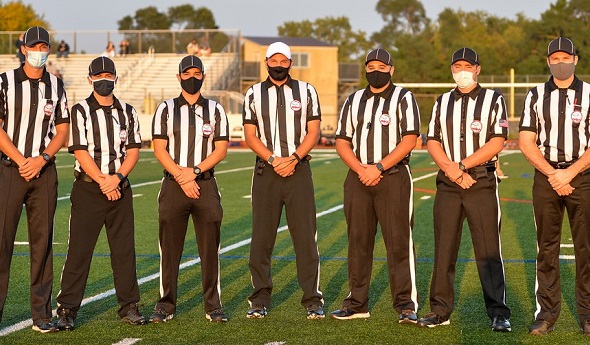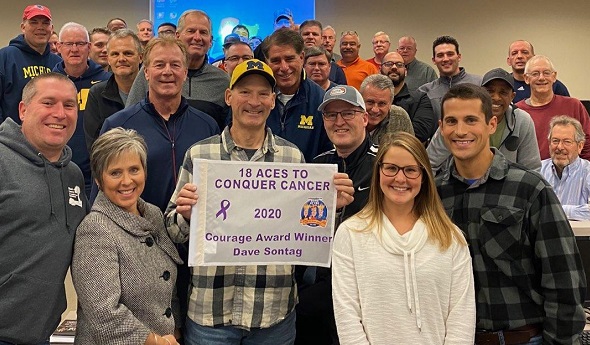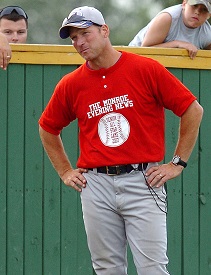
The Official View: The Next Generation
By
Brent Rice
MHSAA Assistant Director
October 27, 2020
By Brent Rice
MHSAA Assistant Director
At a time when we continually hear about the aging population of our veteran officials, it is refreshing to have an entire varsity crew made up of officials under 30.
 The MHSAA continues to push to recruit the next generation of officials. Current officials can do their part by signing up someone new each year … and of any age.
The MHSAA continues to push to recruit the next generation of officials. Current officials can do their part by signing up someone new each year … and of any age.
We kick of our October installment of “The Official View” with this photo of one of those up-and-coming crews.
Pictured above (left to right) are Nick Wallace, Joey Lapinski, Dan Dobrosielski, Nick Meyer, Zach Ferguson, Austin White and Kevin Klein.
It’s Official!
Postseason assignments: Officials in cross country, football, soccer, swim and volleyball are being notified of their postseason assignments. Especially during a year when it has been difficult to find officials to conduct our sports safely and fairly, we appreciate all of those who have been able to put on the uniforms for both the regular and postseason. For those who were not able to officiate this year, we understand; and we look forward to having you back as soon as we can get back to normal.
Meetings & exams: Rules meetings for winter sports have been released, and tournament exams will soon follow. Please make sure to mark Dec. 10 on your calendar as the date when winter postseason eligibility requirements are due for officials.
Guidelines: Officials for all sports can keep up-to-date on facial covering requirements by CLICKING HERE, and stay current on policies for your specific sport by going to the sport-specific officials page of the MHSAA website.
Know Your Rules
SWIMMING For an event requiring a forward start, a swimmer requests permission to start in the water.
Ruling: This is permissible. In order to remain legal though, the swimmer must enter the pool feet first.
It’s Your Call
Last month’s IYC involved a trick play with Team A players leaving the playing field. First this is a no goal, and each of the players that left without the permission of the official should receive a yellow card. However, since the cards occurred during a stoppage of play, and before the kick was made, Team A retains the corner kick when play resumes.
VOLLEYBALL The newest “It’s Your Call” comes from the volleyball court. Team A’s kill attempt is blocked back to its side of the net. As the ball is about to hit the floor, A13 lunges her leg out and kicks the ball in the air. Then, the libero instinctively kicks her leg out, doing the same. Finally, A3 makes a diving dig back to the other side of the net. The ball lands in, near Team B’s end line. What’s the call?
The Official View: What’s in a Uniform
Officials in most sports are identified by the style of their shirts. Soccer referees are well-known for wearing shirts in a variety of bright, stunning colors. For many years, baseball umpires were so closely identified with the color of their uniform tops, they were (and often still are) contemptibly referred to as “Blue.”
But perhaps there is no more iconic uniform shirt than the black and white stripes worn by officials in a number of sports over the last century. In fact, this easily recognizable pattern associated with referees has its origins in Michigan high school sports.
That’s right, the first reported occurrence of any official wearing stripes goes back to the 1921 Michigan high school basketball finals. That referee was Lloyd Olds, and he was a multi-sport official out of Ypsilanti. The idea came to him following an unfortunate incident in a college football game when the Arizona quarterback mistook Olds as a teammate and threw him the football. You see, the Arizona team wore white uniforms, and were very similar looking to Olds’ own officials uniform – consisting of black slacks and a white dress shirt with bow tie. It became apparent to him that officials should wear a uniform that distinguished them from the teams.
When Olds returned home, he sat down with friend and sporting goods store owner, Greg Moe, to design the first black-and-white striped uniform. He decided to pull the uniform shirt out of the closet for the final game of the high school basketball postseason, and soon began wearing it when he worked both basketball and football.
This new outfit quickly caught on at both the high school and college levels, and it wasn’t long before this became the norm around the world and across all levels. While officials’ uniforms regularly change these days, some form of stripes will likely be around forever – and it all started with a Michigan high school official.
If you have an interesting story or an official you’d like to see promoted, send details and pictures to [email protected].

Sontag Inspires Amid 'Miracle' Cancer Fight
January 3, 2020
By Doug Donnelly
Special for Second Half
PINCKNEY – Dave Sontag could tell something was wrong.
 The gymnasium at Petersburg-Summerfield High School is bigger than most in Monroe County. But when Sontag, a veteran official, was running up and down the floor, he felt unusually tired and began feeling pain in his back.
The gymnasium at Petersburg-Summerfield High School is bigger than most in Monroe County. But when Sontag, a veteran official, was running up and down the floor, he felt unusually tired and began feeling pain in his back.
“I knew something was wrong,” Sontag said. “During a timeout, I told one of the other officials who was in the stands watching that he might have to finish the game.”
Sontag, however, pushed through and made it.
“That’s when it all began,” he said.
A few weeks later, as the Saline varsity baseball coach, Sontag was hitting fly balls to the Hornets’ outfielders.
“I was struggling,” he said. “I called the players in and told them something was wrong. I had to stop.”
Still trying to fight through whatever was wrong, Sontag was coaching third base during a Saline intra-squad scrimmage a short time later.
“I started to see white,” he said.
He had another member of the Saline coaching staff call his wife, Michelle, who came and picked him up and took him to the hospital in Chelsea.
“My blood counts were trash, just trash,” he said. “The doctors said I need to have a blood transfusion.”
He was rushed to a Detroit-area hospital for the transfusion. After tests, Sontag was diagnosed with acute lymphoblastic leukemia, an extremely vigorous, aggressive cancer. That was May 15, 2018.
During the 18 months since, Sontag has gone through chemotherapy and radiation treatments. He’s watched multiple communities respond with fundraisers and benefits and amazing support. He’s had more than one bone marrow transplant. He’s heard from countless friends and ex-players who have continued to lift his spirits day after day via e-mails and text messages. He’s been counted out more than once.
Yet, he’s survived.
“Every day has been a challenge,” he said.
***
Sports and Sontag have gone together from the beginning.
He is a Monroe County native who was The Monroe Evening News Player of the Year in baseball in 1978 and went on to play at the University of Toledo. He taught journalism and English at his alma mater, Monroe Jefferson, before becoming a counselor for another 12 years. He was also the Jefferson director of athletics and recreation for a time.
 He coached baseball for the Bears, leading the team to nearly 400 victories and the Division 2 championship in 2002. He stepped down from coaching to follow his kids, who were playing at higher levels; Ryan Sontag played at Arizona State University and in the Chicago Cubs organization. Susan played softball at Bowling Green State University, and Brendan played ball at Indiana Tech University.
He coached baseball for the Bears, leading the team to nearly 400 victories and the Division 2 championship in 2002. He stepped down from coaching to follow his kids, who were playing at higher levels; Ryan Sontag played at Arizona State University and in the Chicago Cubs organization. Susan played softball at Bowling Green State University, and Brendan played ball at Indiana Tech University.
Still, the desire to coach never left their dad.
“After my kids were done playing, I coached freshman baseball at Jefferson,” he said. “I missed it and still wanted to be part of it.”
With his wife a principal in the Saline district, Sontag was asked by Scott Theisen, Saline’s head coach, to join his staff in 2015. He was with the Hornets when they captured the Division 1 championship in 2017, then was named head coach before the 2018 season started.
“That was the year I got sick,” he said. “I didn’t even finish the year.”
Sontag also has been a basketball official for years, getting his start in the early 1980s. He’s been a registered MHSAA high school basketball official for 40 years and has trained officials for the Monroe County Basketball Officials’ Association. He’s called four MHSAA Finals championship games.
“My first varsity game ever was when I was 21,” Sontag said. “I refereed a game at Whiteford.”
***
Sontag previously battled non-Hodgkin’s lymphoma in 1995-1996, beating that disease after a nine-month battle.
Although this cancer battle began as he was new to the Saline community, they embraced his fight, selling “Team Tags” T-shirts and painting the youth baseball diamond with a big ribbon. His son, Ryan, was invited to throw out the first pitch before the youth baseball season started in Dave’s honor.
Back home, in Monroe County, Sontag’s school held similar fundraisers and blood drives.
“I had so much support,” he said. “It was quite amazing to see.”
He tried all sorts of treatments, ultimately boarding an airplane and heading to Seattle for a clinical trial. It didn’t work.
“At that point, I didn’t think I was going to live,” Sontag said. “They told me there was nothing more they could do. They just were giving me something to take the pain away. I was miserable.”
Still, Sontag said, he held out hope.
“I felt it wasn’t time yet,” he said. “I have three grandkids. There are things I want to do. There’s so much I haven’t accomplished yet. In Seattle, they didn’t count on me living.”
But, for a still-unexplained reason, a combination of the medicine he was given to “take the pain away,” on his flight home and a different medicine he received when he returned to Michigan, started to change the way he felt. His blood counts started getting better.
“The side effects were lousy, but, for some reason, it threw me into remission. They checked for leukemia and it was not there.
“We called it a miracle.”
***
Sontag, who lives in Pinckney now, is still dealing with the side effects of nearly two years of treatments. He has a tingling sensation in his arms and legs – the feeling people get when their hands or feet ‘fall asleep’ – and he has a weak immune system.
 But he gets a little better every day.
But he gets a little better every day.
“Every day is a blessing,” he said.
In addition to the community support and constant praying, he credits his wife with guiding him through this process.
“Michelle has been a rock through all of this,” he said. “She’s been by my side every single day. Without her, I don’t know if I would have made it.”
Recently, the Monroe County Officials’ Association held a banquet during which Sontag was presented with a “Courage Award.” He isn’t sure if he’ll be able to referee again anytime soon.
“I told them that night that I’d like to do it again, somewhere,” he said. “I don’t care of it’s a seventh-grade game. I just want to get out there again.”
In addition to the outpouring of love from multiple communities, family and friends, Sontag said sports has kept him alive.
“Sports is part of my fabric,” he said. “Baseball and officiating basketball games has given me that motivation I’ve needed to fight through this. I don’t know if I will coach again or referee again. I’m definitely not going to jump into the same schedule. But there are things I would like to do.
“Will I become a head coach again? Probably not. The task of being a head coach is probably too big right now. But I’d like to be involved. I’d still like to run camps and clinics. I’d still like to officiate too. I want to be a part of it. It’s something that’s in my blood.”
His son Ryan lives in Saline and has three children. Ryan coaches his son in a youth baseball league.
“He called me the other day and asked if I’d help him out,” Dave Sontag said. “I told him I think he will get me out there at some point.”
 Doug Donnelly has served as a sports and news reporter and city editor over 25 years, writing for the Daily Chief-Union in Upper Sandusky, Ohio from 1992-1995, the Monroe Evening News from 1995-2012 and the Adrian Daily Telegram since 2013. He's also written a book on high school basketball in Monroe County and compiles record books for various schools in southeast Michigan. E-mail him at [email protected] with story ideas for Jackson, Washtenaw, Hillsdale, Lenawee and Monroe counties.
Doug Donnelly has served as a sports and news reporter and city editor over 25 years, writing for the Daily Chief-Union in Upper Sandusky, Ohio from 1992-1995, the Monroe Evening News from 1995-2012 and the Adrian Daily Telegram since 2013. He's also written a book on high school basketball in Monroe County and compiles record books for various schools in southeast Michigan. E-mail him at [email protected] with story ideas for Jackson, Washtenaw, Hillsdale, Lenawee and Monroe counties.
PHOTOS: Longtime official and coach Dave Sontag – standing in front row with wife Michelle, daughter-in-law Amy and son Brendan – is presented a “Courage Award” by the Monroe County Officials Association. (Middle) Sontag, formerly baseball coach at Monroe Jefferson and Saline, mans his spot on the baseline. (Below) Sontag with officials, from left, Mike Gaynier, Mike Bitz, Mike Knabusch and Dan Jukuri. (Top and below photos courtesy of Knabusch; middle photo courtesy of the Monroe News.)

